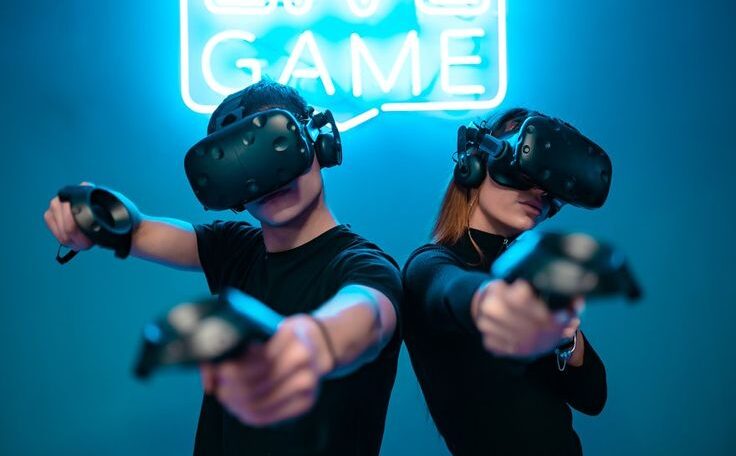
Introduction
Virtual Reality (VR) has long been heralded as the future of gaming, offering an immersive experience that transports players into entirely new worlds. Over the past decade, VR technology has evolved rapidly, transforming from a niche curiosity into a mainstream entertainment medium. With major advancements in hardware, software, and content, VR gaming is poised for significant growth, offering both gamers and developers new opportunities to explore.
In this article, we will explore the latest developments in VR gaming, examine the challenges and opportunities facing the industry, and take a look at what the future might hold for this exciting technology. We will also delve into how VR is reshaping the gaming landscape and how it is likely to evolve in the coming years.
The Evolution of VR Gaming
The concept of VR has been around for decades, with early prototypes and concepts emerging as far back as the 1960s. However, it wasn’t until the 2010s that VR gaming began to gain traction, thanks in large part to the development of more affordable and accessible hardware. The launch of the Oculus Rift in 2012, followed by the HTC Vive and PlayStation VR, marked the beginning of a new era in gaming.
- Early Challenges and Breakthroughs
Early VR systems faced several challenges, including high costs, limited content, and technical limitations such as motion sickness and low resolution. However, these challenges also spurred innovation, leading to significant improvements in VR technology. Advances in display technology, motion tracking, and ergonomic design have made VR headsets more comfortable, immersive, and user-friendly.
One of the most significant breakthroughs came with the introduction of room-scale VR, which allows users to move around in a physical space while interacting with a virtual environment. This innovation, first popularized by the HTC Vive, added a new layer of immersion to VR gaming, making it possible for players to engage with virtual worlds in a more natural and intuitive way.
- Growth of the VR Gaming Market
As the technology has matured, the VR gaming market has grown rapidly. According to industry reports, the global VR gaming market is expected to reach $45 billion by 2027, driven by the increasing adoption of VR headsets, the expansion of VR content libraries, and the growing interest in immersive gaming experiences.
This growth has been fueled by a combination of factors, including the decreasing cost of VR hardware, the rise of high-quality VR content, and the increasing integration of Virtual Reality into popular gaming platforms. Today, VR gaming is no longer a niche market but a significant segment of the broader gaming industry.
- The Role of Major Players
Several major players have been instrumental in the development and popularization of Virtual Reality gaming. Oculus, now owned by Meta (formerly Facebook), has been a leader in the VR space, with its Oculus Rift and Quest headsets setting the standard for consumer VR. The Oculus Quest 2, in particular, has been a game-changer, offering a standalone, wireless VR experience that is both affordable and accessible.
Sony’s PlayStation VR has also played a key role in bringing VR to the masses, particularly among console gamers. With the upcoming release of the PlayStation VR2, Sony is poised to further solidify its position in the Virtual Reality gaming market.
Other notable players include Valve, with its high-end Valve Index headset, and HTC, which continues to innovate with its Vive line of products. Additionally, companies like Google and Microsoft have explored mixed reality (MR) and augmented reality (AR) technologies, which intersect with Virtual Reality and offer new possibilities for immersive gaming experiences.
Latest Developments in VR Gaming
The VR gaming industry is constantly evolving, with new developments and innovations emerging on a regular basis. Below are some of the latest trends and advancements that are shaping the future of VR gaming.
- Improved Hardware and Accessibility
One of the most significant recent developments in VR gaming is the continued improvement of VR hardware. Modern VR headsets are lighter, more comfortable, and offer higher resolution displays than their predecessors. The Oculus Quest 2, for example, features a 1832 x 1920 resolution per eye, offering a crisp and clear visual experience that rivals traditional gaming monitors.
In addition to improved displays, advancements in motion tracking and haptic feedback have enhanced the sense of immersion in Virtual Reality games. New controllers, such as the Oculus Touch and Valve Index controllers, offer precise tracking of hand movements and provide realistic feedback, making interactions within Virtual Reality worlds feel more natural.
Another important development is the increasing accessibility of VR hardware. Standalone headsets like the Oculus Quest 2 have removed the need for expensive gaming PCs, making VR gaming more affordable and accessible to a wider audience. This trend is likely to continue as hardware costs decrease and new innovations make VR more user-friendly.
- Expansion of Virtual Reality Content Libraries
As VR hardware has improved, so too has the quality and diversity of VR content. Today, VR gamers have access to a wide range of titles, from immersive single-player experiences to social multiplayer games. Popular genres in VR gaming include first-person shooters, puzzle games, horror, and simulation games.
Some of the most successful VR titles in recent years include “Half-Life: Alyx,” a critically acclaimed first-person shooter set in the “Half-Life” universe, and “Beat Saber,” a rhythm game that has become one of the best-selling VR games of all time. Other notable titles include “The Walking Dead: Saints & Sinners,” “Superhot VR,” and “No Man’s Sky VR.”
In addition to standalone VR games, many traditional games are being adapted for VR, allowing players to experience their favorite titles in a new and immersive way. For example, games like “Skyrim VR,” “Resident Evil 7: Biohazard,” and “Doom VFR” have been reimagined for VR, offering fans a fresh perspective on familiar content.
- Social and Multiplayer VR Experiences
Social interaction is becoming an increasingly important aspect of VR gaming. VR platforms such as VRChat, Rec Room, and AltspaceVR allow users to interact with others in virtual environments, creating a sense of community and shared experience. These platforms offer a range of activities, from casual socializing to collaborative games and events, making VR a more social and connected experience.
Multiplayer VR games are also growing in popularity, with titles like “Echo VR,” “Population: One,” and “Star Trek: Bridge Crew” offering cooperative and competitive gameplay in immersive virtual worlds. The rise of social and multiplayer VR experiences is helping to broaden the appeal of VR gaming, attracting players who are interested in connecting with others in new and exciting ways.
- Virtual Reality in Esports and Competitive Gaming
Esports is another area where VR gaming is beginning to make an impact. While traditional esports titles like “League of Legends” and “Counter-Strike: Global Offensive” dominate the scene, VR games are starting to gain traction as competitive titles.
Games like “Echo VR” and “Onward” have developed dedicated esports communities, with organized tournaments and competitive play. The immersive nature of Virtual Reality adds a new dimension to esports, requiring players to master both physical and mental skills to succeed.
As VR technology continues to evolve, it’s likely that we will see more VR games enter the competitive gaming arena, offering new opportunities for both players and spectators.
- Cross-Platform Play and Integration
Cross-platform play is becoming increasingly common in VR gaming, allowing players to interact with others regardless of the hardware they use. This trend is helping to break down barriers within the VR community, creating a more unified and inclusive gaming experience.
For example, games like “Rec Room” and “Population: One” support cross-platform play between Oculus, HTC Vive, and PlayStation VR, allowing players to team up or compete against each other regardless of their device. This level of integration is helping to expand the VR player base and create a more connected gaming ecosystem.
- The Intersection of VR and AR
While VR immerses users in entirely virtual environments, augmented reality (AR) overlays digital content onto the real world. The intersection of VR and AR, often referred to as mixed reality (MR), is a growing area of interest in the tech industry.
MR devices like the Microsoft HoloLens and Magic Leap offer new possibilities for gaming, combining the immersion of VR with the real-world context of AR. These technologies are still in their early stages, but they have the potential to create new and innovative gaming experiences that blend the virtual and physical worlds.
The Future of Virtual Reality Gaming
The future of VR gaming is bright, with several trends and developments set to shape the industry in the coming years. Below are some predictions for the future of VR gaming:
- Mainstream Adoption
As VR technology continues to improve and become more accessible, we can expect to see wider mainstream adoption of VR gaming. The success of devices like the Oculus Quest 2 has demonstrated that there is a significant market for affordable, standalone VR systems, and this trend is likely to continue.
Mainstream adoption will also be driven by the increasing availability of high-quality content and the expansion of VR gaming platforms. As more developers create compelling VR experiences, the appeal of VR gaming will continue to grow, attracting a broader audience.
- Advances in Haptic Feedback and Immersion
Haptic feedback, which provides tactile sensations to users, is an area of ongoing innovation in VR gaming. Future advancements in haptic technology could allow for even more immersive experiences, with players feeling physical sensations that correspond to actions in the virtual world.
For example, haptic suits and gloves could provide realistic feedback for actions like grabbing objects, firing weapons, or feeling environmental effects like wind or temperature changes. These advancements will enhance the sense of presence in VR, making the virtual world feel even more real.
- Cloud Gaming and VR
Cloud gaming, which allows users to stream games from remote servers, is another trend that could have a significant impact on VR gaming. By offloading the processing power to the cloud, cloud gaming could make high-quality VR experiences more accessible, even for users with less powerful hardware.
This approach could also reduce the need for expensive gaming PCs or consoles, making VR gaming more affordable and widespread. As cloud gaming technology continues to evolve, it will likely play a key role in the future of VR gaming.
- Integration with Artificial Intelligence
Artificial intelligence (AI) is increasingly being used in gaming to create more dynamic and responsive experiences. In VR gaming, AI could be used to enhance NPC (non-player character) behavior, create more realistic environments, and provide personalized gameplay experiences.
For example, AI could be used to adapt the difficulty of a game based on the player’s skill level or to generate procedurally created content that evolves over time. These advancements will contribute to more engaging and immersive VR experiences.
- Expansion into New Genres and Applications
While VR gaming has traditionally focused on genres like first-person shooters, puzzle games, and simulation, the technology has the potential to expand into new genres and applications. For example, VR could be used for educational games, virtual tourism, and creative applications like virtual art galleries or design studios.
The flexibility of VR technology allows for a wide range of applications beyond traditional gaming, and as the technology continues to evolve, we can expect to see new and innovative uses for VR.
- Enhanced Social and Multiplayer Experiences
The social aspect of VR gaming will continue to grow, with more emphasis on multiplayer experiences and virtual social interactions. As VR platforms become more sophisticated, they will support larger and more complex social interactions, including virtual events, concerts, and gatherings.
These developments will create new opportunities for players to connect and collaborate in virtual spaces, enhancing the social aspects of VR gaming and creating a more vibrant and interconnected community.
Conclusion
VR gaming has come a long way since its early days, with significant advancements in hardware, content, and accessibility driving the industry forward. The latest developments in VR technology are reshaping the gaming landscape, offering new and immersive experiences for players around the world.
As we look to the future, the potential for VR gaming is vast, with innovations in hardware, software, and social interactions set to shape the industry in exciting new ways. Whether you’re a seasoned VR enthusiast or new to the world of virtual reality, there’s never been a better time to explore the possibilities of VR gaming.
By staying informed about the latest trends and developments, gamers and developers alike can be part of the next wave of VR innovation, contributing to a dynamic and evolving industry that continues to push the boundaries of what’s possible.



